Physical Count Process
Before you can perform a Physical Count for all items in your store, you must set up a store layout plan to divide your store into manageable sections. Each section will have its own count sheet showing the items in that section. These count sheets can then be distributed to the associates responsible for counting each section. Refer to Store Layout Maintenance for more information about setting up your store layout.
The initial step in the Physical Count process is to find an existing Inventory Count document, or to create a new document if allowed by your store policy.
See Inventory Count Documents for detailed information about locating an Inventory Count document. See Creating a New Inventory Count Document for detailed information about creating an Inventory Count document.
Once the Inventory Count document is located, perform the following steps:
-
Select the Physical Count document you want to count and select Process. The system displays the Physical Count screen.
-
Select the Generate Count Sheets menu option on the Physical Count screen to create the count sheets based on your store layout. This screen shows the following information for the new Physical Count:
Figure 5-27 Physical Count Screen - Count Sheet LIst
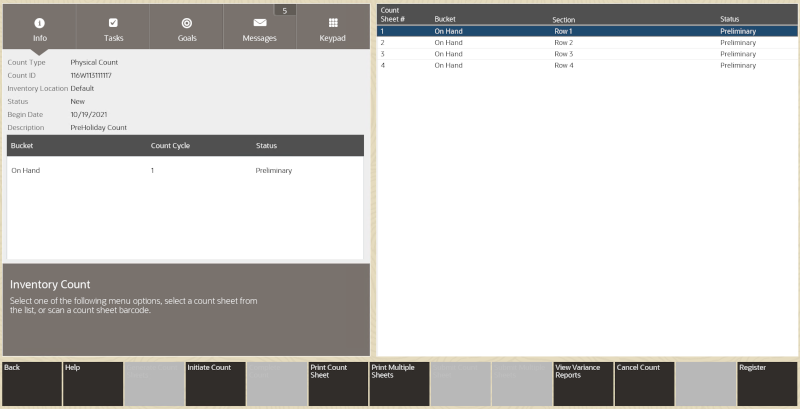
The top left area of the screen displays the information for the Inventory Count document: Store ID, Count ID number, Count Type, Description, Begin Date, and Count Status.
Beneath this area of the screen displays information for the count sheet:
-
Bucket - The inventory bucket identifier for this count sheet. Inventory buckets are pre-defined for your store.
-
Count Cycle - Indicates the number of times the bucket has been counted in order to reconcile any count variances and complete the count. The count cycle will always be set to 1 for the first count. If additional counts are needed to resolve a discrepancy, this number will increment for each recount.
-
Status - The status of the bucket within the current count and cycle:
-
Preliminary - The beginning status for a new count.
-
Printed - Indicates the count sheet has been printed.
-
Saved - Indicates the count sheet has been saved.
-
Complete - Indicates the count sheet has been completed.
-
On the right, the screen lists each count sheet based on your store layout:
-
Count Sheet # - The sequential number associated with each count sheet for this Physical Count.
-
Bucket - The inventory bucket associated with the count sheet.
-
Section - The store area to be counted as defined in your store layout.
-
Status - The status for each count sheet.
-
-
Print the count sheets:
-
To print one count sheet at a time, highlight the count sheet and select the Print Count Sheet menu option. The count sheet is printed, and the status will be updated from Preliminary to Printed.
Figure 5-28 Count Sheet - Status Printed

-
To print multiple count sheets, select the Print Multiple Sheets menu option. The system prompts you to select the count sheets to be printed. With the count sheet highlighted, press the Spacebar to select each sheet individually, or choose the Select All menu option to print all sheets. When prompted, select Yes to confirm the count sheets to be printed. The count sheet status will be updated from Preliminary to Printed.
Figure 5-29 Select Count Sheets Prompt
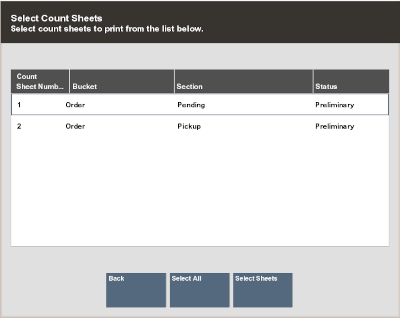
Figure 5-30 Printed Count Sheet Example
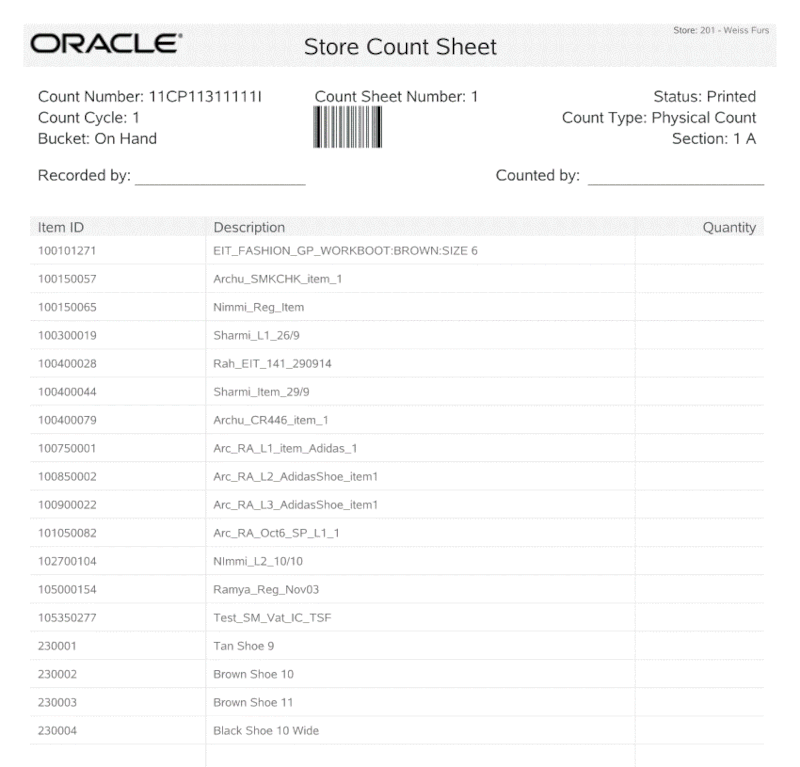
Use the printed count sheets to record the item counts. Blank lines are provided so that you can write in any items you find in the section that were not included on the printed list. When you have finished counting the items, return to the Inventory module to enter your counts into the system.
Note:
If allowed by your store policy, you can enter your counts before initiating the count.
If enforced by your store policy, you cannot enter your counts until the count has been initiated. See step 4.
-
-
Select Initiate Count to take a snapshot of current inventory. If the store is open, a warning message is displayed. Select Yes to continue and the Count Status changes to initiated, or No to exit the count.
Note:
About the count menu options:
Initiate Count BASED ON SECURITY PRIVILEGE - This process allows your counts to be compared to the snapshot system-expected quantity. Depending on your store policy, you may be required to initiate the count before entering any counts into the system. Or, if your store policy allows, you may be able to enter your counts before initiating the count.
Cancel Count BASED ON SECURITY PRIVILEGE - This option allows you to cancel your count up until it is completed. Only store-created Inventory Counts can be cancelled. When prompted, select Yes to cancel the count.
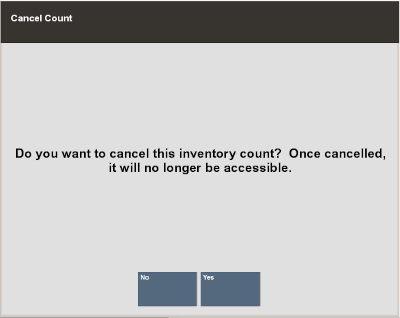
About the count menu options:
Initiate Count BASED ON SECURITY PRIVILEGE - This process allows your counts to be compared to the snapshot system-expected quantity. Depending on your store policy, you may be required to initiate the count before entering any counts into the system. Or, if your store policy allows, you may be able to enter your counts before initiating the count.
Cancel Count BASED ON SECURITY PRIVILEGE - This option allows you to cancel your count up until it is completed. Only store-created Inventory Counts can be cancelled. When prompted, select Yes to cancel the count
Complete Count BASED ON SECURITY PRIVILEGE - This option marks the count sheet as complete. The Complete Count menu option will only be enable after the count cycles for the inventory count are complete.
Esc - This option will exit the current Count document and take you back to the Inventory Count search form (Figure 5-4).
-
Now count the items listed on the count sheets...
When you have finished counting the inventory items, return to the Inventory module to enter your counts into the system. Refer to Physical Count Process if you need instructions for locating the Inventory Count document you are working on.
-
At the Physical Count screen, select a count sheet from the list and press Enter, or scan the barcode from the count sheet to display the items in the bucket and section.
-
In the Enter Count prompt, enter a quantity for the selected item and press Enter. Xstore will enter the count and move to the next item in the list.
Note:
f you counted any items that are not found on the list, select the Add Count Item menu option. When prompted, enter or scan the item ID and enter the quantity you counted for this item.

-
Select Save Count Sheet. Repeat steps 6-8 for all count sheets.
-
Submit the counts.
In this step, your count is compared to the system-expected quantity captured during the initiation process. Any variances between your count and the system- expected quantity will be reported, allowing you to resolve any discrepancies through additional counting cycles.
-
To submit a single count sheet, select the count sheet in the list and select the Submit Count Sheet option.
-
To submit multiple count sheets at one time, select the Submit Multiple Sheets menu option. The system prompts you to select the count sheets to be submitted. With the count sheet highlighted, press the Spacebar to select each sheet individually, or choose the Select All menu option to submit all sheets. When prompted, select Yes to confirm the count sheets to be submitted.
Figure 5-31 Count Sheets List

-
-
The next step depends on the type of variance processing used: Automatic or Manual.
-
If the counted quantity and the expected Snapshot quantity match, the inventory bucket for the item is marked as settled – no variance, and the count is complete.
-
If the counted quantity and the expected Snapshot quantity do not match, the inventory bucket for the item is marked as having a variance.
-
If your system is set up for Automatic Variance Processing, any variances will result in a new count cycle: Count Cycle 2. See Automatic Variance Processing for detailed information about this type of variance processing.
-
If your system is set up for Manual Variance Processing, you can choose whether to perform a recount. See Manual Variance Processing for detailed information about this type of variance processing.
-
Note:
In Count Cycle 2 (and higher), all items with variances will be grouped by Bucket. The Sections used for counting in Cycle 1 are not used for Cycle 2 and greater.
For example, if you have sections within the Layaway bucket such as an Earrings Section, a Watch Section, and a Jewelry Section with variances reported in Cycle 1 (1), then in Count Cycle 2 (2), the three Layaway sections (Earrings Section, Watch Section, and Jewelry Section) will be consolidated into a single Layaway bucket and the Section identifier will be ignored.
-
-
If you must recount any items, perform the same steps you used for count cycle 1:
Note:
Since subsequent count cycles are always compared to the initial snapshot taken for the first count cycle, you cannot initiate the count again.
-
Print the count sheet. Only the items with variances will be listed for a recount.
-
You cannot add additional items to Count Cycle 2.
-
When the recount is finished and saved, select the Submit Count Sheet menu option. Once again, the system will compare the entered counts with the expected counts.
-
-
You can select the View Variance Reports menu option to create a variance report showing the count discrepancies. When prompted, select a Variance Report from the list and press Enter. The system creates and displays the report.
-
After the final count cycle sheet is submitted, the system displays a prompt indicating you have completed all count cycles.
Figure 5-32 Inventory Count Cycles Complete Prompt
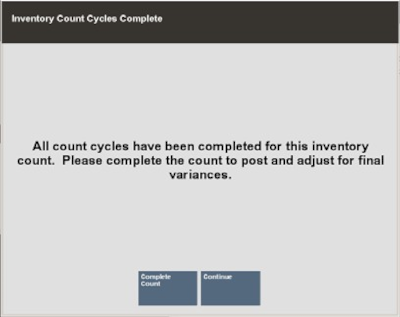
-
Select one of the following options to continue the counting process:
-
Select Continue to return to the Inventory Count screen. From the Inventory Count screen, you can:
-
View/Print Variance Reports from all count cycles that had variances.
Note:
No Variance Report will be available for a count cycle that had no variances since all variance values would be 0.
-
Save the submitted count cycles and post inventory counts at another time.
-
Print count sheets.
-
Cancel the count.
-
Complete the count to post inventory counts and adjust the inventory counts in the system.
<OR>
-
-
Select Complete Count to post inventory counts and adjust the inventory counts in the system.
-
-
After completing the count sheets, the system marks the Inventory Count document as Complete and inventory quantity will be adjusted accordingly.